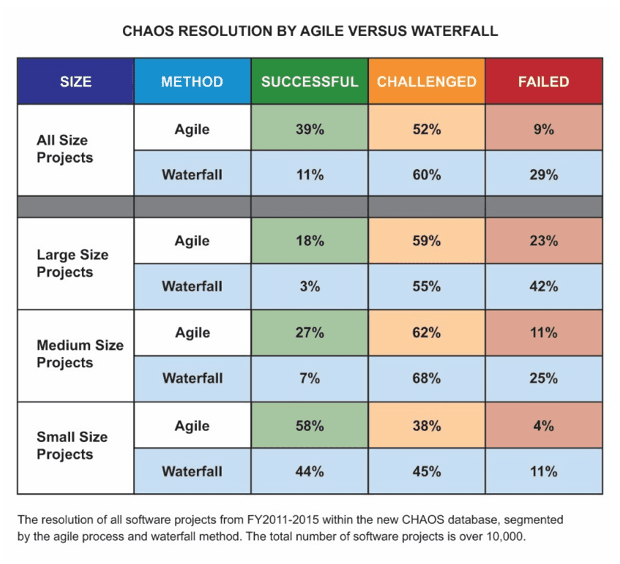At its core, agile project management is an empirical approach to projects, focused on incremental delivery of highest business value through:
- Scope flexibility
- Iterative planning, development and testing
- Continuous improvement of product and process through customer feedback and team input
You can get a quick explainer by watching our video.
“Agile” defined
Agile, in project management, is actually an umbrella term and a descriptor, not a methodology. To be agile means to be able to move quickly, easily and nimbly. That is exactly its meaning in project management.
Agile project management roots
In 2001, a group of seventeen project management and software development experts got together to discuss what their successful projects had in common. They had all struggled with the formal, step-based project management processes developed to meet the demands of major advances in computer technology during World War II. Based on their respective experiments with lighter-weight, adaptive approaches, as well as previous models and research by Walter Sherwart, Winston Royce, Hirotaka Takeuchi and Ikujiro Nonaka, they collaboratively published “A Manifesto for Agile Software Development,” commonly known as the agile manifesto.
Manifesto for agile software development
We are uncovering better ways of developing software by doing it and helping others do it. Through this work we have come to value:
Individuals and interactions over processes and tools
Working software over comprehensive documentation
Customer collaboration over contract negotiation
Responding to change over following a plan
That is, while there is value in the items on the right, we value the items on the left more.
Kent Beck, Mike Beedle, Arie van Bennekum, Alistair Cockburn, Ward Cunningham, Martin Fowler, James Grenning, Jim Highsmith, Andrew Hunt, Ron Jeffries, Jon Kern, Brian Marick, Robert C. Martin, Steve Mellor, Ken Schwaber, Jeff Sutherland, Dave Thomas
© 2001, the above authors
this declaration may be freely copied in any form, but only in its entirety through this notice.
There are also 12 principles that support the values in the manifesto, which can be found here.
There is no such thing as the agile methodology or framework. As the agile manifesto gained exposure, many tried to turn the word agile into a thing (i.e. noun, or even a proper noun) rather than a descriptor (i.e. adjective).
The agile manifesto is the authoritative source—a litmus test—for organizations to determine whether they are being agile in their decisions, processes, mindsets, culture, and target outcomes. Many frameworks (e.g. scrum for project management), methodologies (e.g. XP for engineering practices), environments (e.g. lean approaches such as kanban), and techniques exist for managing projects based on agile values and principles.
Why agile project management?
These values and principles modernize project management to focus on the right things at the right time, respond efficiently to change, and effectively deliver what customers need.
Any size or complexity project will benefit from agile approaches, but the larger and more complex the project, the more opportunity it has to improve. According to the Standish Group, 95% of organizations are in some state of agile transformation. From 2011-2015, they evaluated 10,000 projects of various sizes to evaluate whether or not they completed successfully (i.e. on time and on budget with all planned functionality), challenged (i.e. completed, but over budget, over time with less functionality than planned), or otherwise failed (i.e. canceled at some point).

Copyright© 2015 Standish Group – Resolution by agile versus waterfall 2011-2015
Of the 10,000 projects evaluated, the percentage of successful projects using an agile approach was significantly higher than other waterfall approaches. Even with small projects where simple approaches may be sufficient, agile approaches were 30% more likely to succeed. With medium-sized projects, agile approaches are almost 4x (400%) more likely to succeed, and with large, complex projects, agile approaches are 6x (600%) more likely to succeed.
The agile values and principles are the heart and soul of agile project management. Agile frameworks, methodologies, environments, and techniques all give teams the capacity to deal with uncertainty and to be flexible with changing requirements.
Because agile project management generally involves creating products in iterations, with the most valuable features first, it allows companies to deliver the essential parts of products to market quickly. Agile project management also allows teams to fail quickly, spending less time and money on efforts that will not work. Finally, by being people-focused, agile project management gives project teams more optimal and sustainable working environments, encouraging people to do their greatest work.
Learn more about agile project development
You can learn all about agile project development by purchasing our book, Agile Project Development for Dummies. The new third edition is now available! Buy it today.







